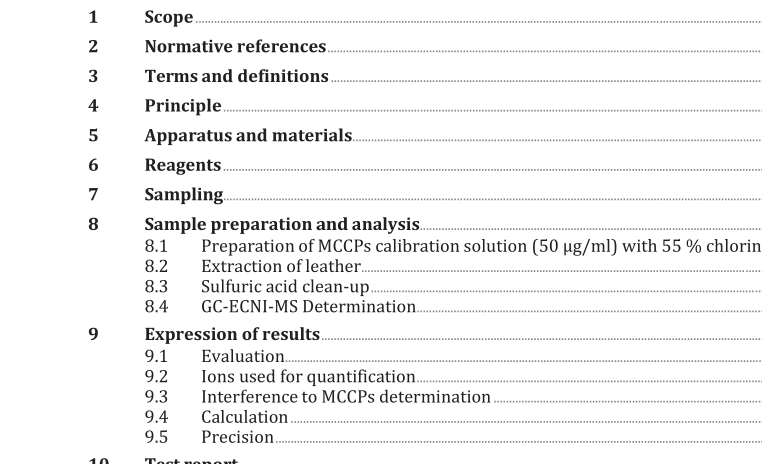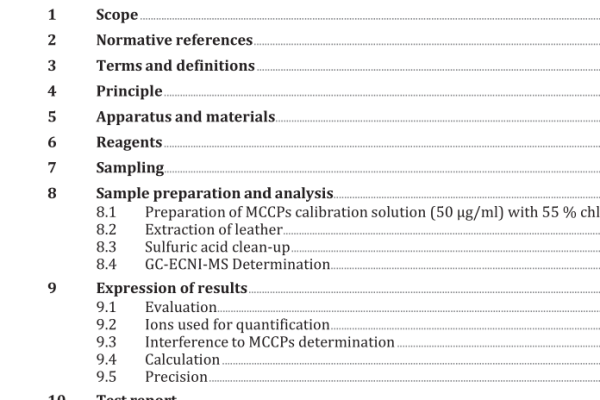ISO 18219-2:2021 pdf download – Leather — Determination of chlorinated hydrocarbons in leather — Part 2: Chromatographic method for middle- chain chlorinated paraffins (MCCPs).
1 Scope This document specifies a chromatographic method to determine the amount of middle-chain chlorinated paraffins (MCCPs) C 14 to C 17 in processed and unprocessed leathers. 2 Normative references The following documents are referred to in the text in such a way that some or all of their content constitutes requirements of this document. For dated references, only the edition cited applies. For undated references, the latest edition of the referenced document (including any amendments) applies. ISO 2418, Leather — Chemical, physical and mechanical and fastness tests — Sampling location ISO 4044, Leather — Chemical tests — Preparation of chemical test samples 3 Terms and definitions No terms and definitions are listed in this document. ISO and IEC maintain terminological databases for use in standardization at the following addresses: — ISO Online browsing platform: available at https://www.iso .org/obp — IEC Electropedia: available at http://www.electropedia .org/ 4 Principle The test sample is extracted using n-hexane at 60 °C in an ultrasonic bath for 60 min. After a sulfuric acid clean-up, an aliquot is then analysed using a gas chromatograph coupled to a mass selective detector with chemical ionization (GC-ECNI-MS). A liquid chromatography system single quad (LC-MS) or with triple quad mass spectrometry (LC- MS/MS), as described in Annex B , can also be used if the user has demonstrated that the accuracy of measurement is equivalent to that of the GC-ECNI-MS method. In some cases when determining MCCPs using the GC-ECNI-MS method, the presence of sulfochlorinated paraffins and equivalent chain-length chloroalkenes can cause interference. Annex B proposes a LC- MS/MS application method that aims to give a better resolution and eliminates possible false positives determined with the GC-ECNI-MS method. 5 Apparatus and materials Use normal laboratory apparatus and, in particular, the following.
5.1 Analytical balance. 5.2 Sealable vessel, with lid, 20 ml, suitable for extraction with n-hexane. 5.3 Ultrasonic bath, with controllable heating capable of maintaining a temperature of (60 ± 5) °C. NOTE A frequency of 40KHz is suitable. 5.4 Pipette, 1 ml to 10 ml capacity. 5.5 Volumetric flask, 2 ml. 5.6 Gas chromatograph and mass selective detector with chemical ionization (GC-ECNI-MS). 5.7 Shaker or agitator, ensuring an efficient mixing of the phases. 6 Reagents If not otherwise defined, analytical reagent grade chemicals shall be used. 6.1 n-hexane, Chemical Abstracts Service (CAS) No 110-54-3. 6.2 Internal standard (IS) solution, lindane, CAS No 58-89-9, 1 000 µg/ml. 6.3 6.3.1 6.3.2 NOTE Standard solutions, MCCPs, C 14 to C 17 , with different chlorine content, each 100 µg/ml. MCCPs C 14 to C 17 52 % Cl , technical grade, CAS 85535-85-9. MCCPs C 14 to C 17 57 % Cl, technical grade. These MCCP calibration solutions are available commercially. 6.4 Concentrated sulfuric acid, (ρ = 1,84 g/ml at 20 °C). 7 Sampling Sample in accordance with ISO 2418. If sampling in accordance with ISO 2418 is not possible (e.g. leathers from finished products like shoes, garments), provide details about sampling together with the test report. Glue residuals shall be mechanically removed from leather samples.
ISO 18219-2:2021 pdf download – Leather — Determination of chlorinated hydrocarbons in leather — Part 2: Chromatographic method for middle- chain chlorinated paraffins (MCCPs)






